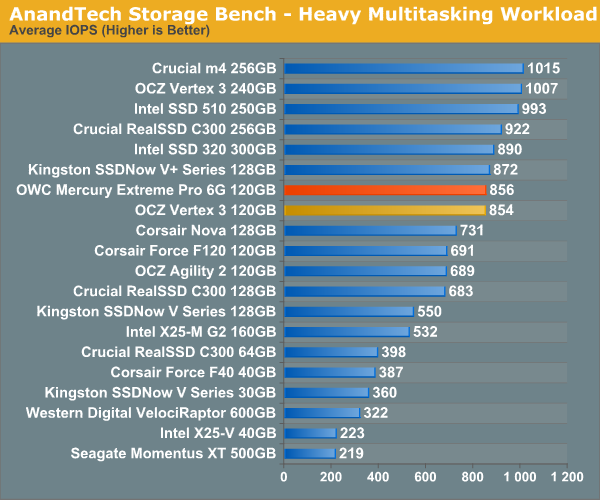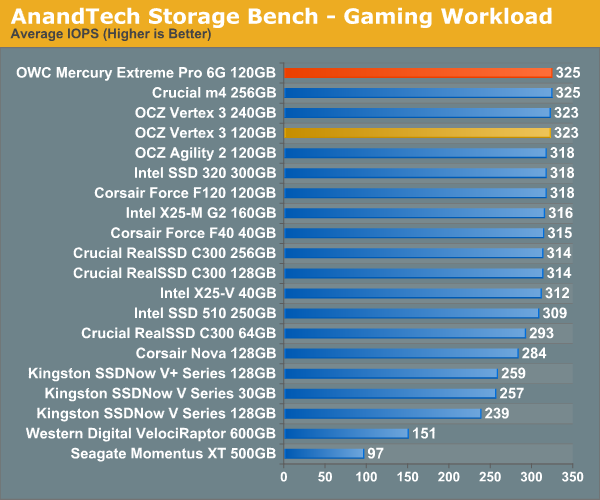OWC Mercury Extreme Pro 6G SSD Review (120GB)
by Anand Lal Shimpi on May 5, 2011 1:45 AM ESTAnandTech Storage Bench 2010
To keep things consistent we've also included our older Storage Bench. Note that the old storage test system doesn't have a SATA 6Gbps controller, so we only have one result for the 6Gbps drives.
The first in our benchmark suite is a light/typical usage case. The Windows 7 system is loaded with Firefox, Office 2007 and Adobe Reader among other applications. With Firefox we browse web pages like Facebook, AnandTech, Digg and other sites. Outlook is also running and we use it to check emails, create and send a message with a PDF attachment. Adobe Reader is used to view some PDFs. Excel 2007 is used to create a spreadsheet, graphs and save the document. The same goes for Word 2007. We open and step through a presentation in PowerPoint 2007 received as an email attachment before saving it to the desktop. Finally we watch a bit of a Firefly episode in Windows Media Player 11.
There’s some level of multitasking going on here but it’s not unreasonable by any means. Generally the application tasks proceed linearly, with the exception of things like web browsing which may happen in between one of the other tasks.
The recording is played back on all of our drives here today. Remember that we’re isolating disk performance, all we’re doing is playing back every single disk access that happened in that ~5 minute period of usage. The light workload is composed of 37,501 reads and 20,268 writes. Over 30% of the IOs are 4KB, 11% are 16KB, 22% are 32KB and approximately 13% are 64KB in size. Less than 30% of the operations are absolutely sequential in nature. Average queue depth is 6.09 IOs.
The performance results are reported in average I/O Operations per Second (IOPS):

If there’s a light usage case there’s bound to be a heavy one. In this test we have Microsoft Security Essentials running in the background with real time virus scanning enabled. We also perform a quick scan in the middle of the test. Firefox, Outlook, Excel, Word and Powerpoint are all used the same as they were in the light test. We add Photoshop CS4 to the mix, opening a bunch of 12MP images, editing them, then saving them as highly compressed JPGs for web publishing. Windows 7’s picture viewer is used to view a bunch of pictures on the hard drive. We use 7-zip to create and extract .7z archives. Downloading is also prominently featured in our heavy test; we download large files from the Internet during portions of the benchmark, as well as use uTorrent to grab a couple of torrents. Some of the applications in use are installed during the benchmark, Windows updates are also installed. Towards the end of the test we launch World of Warcraft, play for a few minutes, then delete the folder. This test also takes into account all of the disk accesses that happen while the OS is booting.
The benchmark is 22 minutes long and it consists of 128,895 read operations and 72,411 write operations. Roughly 44% of all IOs were sequential. Approximately 30% of all accesses were 4KB in size, 12% were 16KB in size, 14% were 32KB and 20% were 64KB. Average queue depth was 3.59.

The gaming workload is made up of 75,206 read operations and only 4,592 write operations. Only 20% of the accesses are 4KB in size, nearly 40% are 64KB and 20% are 32KB. A whopping 69% of the IOs are sequential, meaning this is predominantly a sequential read benchmark. The average queue depth is 7.76 IOs.











44 Comments
View All Comments
Anand Lal Shimpi - Thursday, May 5, 2011 - link
Those drivers were only used on the X58 platform, I use Intel's RST10 on the SNB platform for all of the newer tests/results. :)Take care,
Anand
iwod - Thursday, May 5, 2011 - link
I lost count of many times i post this series. Anyway people continue to worship 4K Random Read Write now have seen the truth. Seq Read Write is much more important then u think.Since the test are basically two identical pieces of Hardware, but one with Random Write Cap, the results shows real world doesn't show any advantage. We need more Seq performance!
Interestingly we aren't limited by the controller or NAND itself. But the connection method, SATA 6Gbps. We need to start using PCI-Express 4x slot, as Intel has shown in the leaked roadmap. Going to PCI-E 3.0 would give us 4GB/s with 4x slot. That should be plenty of room for improvement. ONFI 3.0 next year should allow us to reach 2GB+ Seq Read Write easily.
krumme - Thursday, May 5, 2011 - link
I think Anand heard to much to Intel voice in this ssd story4k random madness was Intel g2 business
And all went in the wrong direction
Anand was - and is - the ssd review site
Anand Lal Shimpi - Thursday, May 5, 2011 - link
The fact of the matter is that both random and sequential performance is important. It's Amdahl's law at its best - if you simply increase the sequential read/write speed of these drives without touching random performance, you'll eventually be limited by random performance. Today I don't believe we are limited by random performance but it's still something that has to keep improving in order for us to continue to see overall gains across the board.Take care,
Anand
Hrel - Thursday, May 5, 2011 - link
Damn! 200 dollars too expensive for the 120GB. Stopped reading.snuuggles - Thursday, May 5, 2011 - link
Good lord, every single article that discusses OWC seems to include some sort of odd-ball tangent or half-baked excuse for some crazy s**t they are pulling.Hey, I know they have the fastest stuff around, but there's just something so lame about these guys, I have to say on principle: "never, ever, will I buy from OWC"
nish0323 - Thursday, August 11, 2011 - link
What crazy s**t are they pulling? I've got 5 drives from them, all SSDs, all perform great. The 6G ones have a 5-year warranty, 2 longer than all other SSD manufacturers right now.neotiger - Thursday, May 5, 2011 - link
A lot of people and hosting companies use consumer SSD for server workload such as MySQL and Solr.Can you benchmark these SSD's performances on server workload?
Anand Lal Shimpi - Thursday, May 5, 2011 - link
It's on our roadmap to do just that... :)Take care,
Anand
rasmussb - Saturday, May 7, 2011 - link
Perhaps you have answered this elsewhere, or it will be answered in your future tests. If so, please forgive me.As you point out, the drive performance is based in large part upon the compressibility of the source data. Relatively incompressible data results in slower speeds. What happens when you put a pair (or more) of these in a RAID 0 array? Since units of data are alternating between drives, how does the SF compression work then? Does previously compressible data get less compressible because any given drive is only getting, at best (2-drive array) half of the original data?
Conversely, does incompressible data happen to get more compressible when you're splitting it amongst two or more drives in an array?
Server workload on a single drive versus in say a RAID 5 array would be an interesting comparison. I'm sure your tech savvy minds are already over this in your roadmap. I'm just asking in the event it isn't.